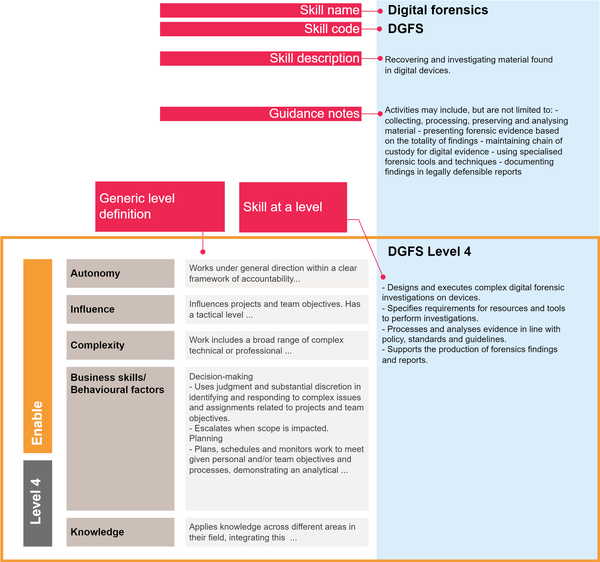How SFIA works - Levels of responsibility and skills
Explore SFIA’s seven levels of responsibility, outlining the progression of responsibility, accountability and impact, and how professional skills and generic attributes define competence and support professional growth.

SFIA provides a structured approach to defining and developing professional skills and competencies in the digital world. At its core, SFIA uses a seven-level structure to describe both professional skills and generic attributes, creating a consistent framework for assessing and developing capabilities.
In this section:
- Seven levels of responsibility
- Essence of a SFIA level
- Generic attributes
- Business skills/behavioural factors
- Knowledge attribute
- Professional skills
- Integration of professional skills and generic attributes
Seven levels of responsibility

SFIA is structured around seven levels of responsibility, ranging from Level 1 (the lowest) to Level 7 (the highest). Each level represents increasing expertise and responsibility in professional roles. These levels form the backbone of SFIA, offering a common language to describe roles across various professional disciplines.
SFIA describes skills and competencies at levels that reflect real-world professional practices in the workplace. Each level is carefully defined to be:
- Progressive: Building on the previous level's requirements
- Distinct: Clearly differentiated from adjacent levels
- Consistent: Using uniform criteria across all skills
The levels are characterised by specific behaviours, values, knowledge and characteristics that indicate an individual's operational capability at that level. This structured approach ensures clarity and consistency in assessing professional development across various disciplines.
Each level is also summarised with a guiding phrase:
- Follow
- Assist
- Apply
- Enable
- Ensure and advise
- Initiate and influence
- Set strategy, inspire, mobilise
Each SFIA level builds upon the previous one in terms of responsibility, accountability and impact, while recognising the value of all levels.
Essence of a SFIA level
Each of these levels is supported by concise essence statements, which provide a distilled view of the unique characteristics of each level. They help users easily distinguish between levels and understand progression without needing to dive into detailed descriptions.

Generic attributes
SFIA defines key attributes that are common to all the SFIA Professional skills and apply at each level of responsibility. These generic attributes describe how professionals operate within their roles and contribute to the organisation.
- Autonomy: The level of independence, discretion and accountability for results in your role.
- Influence: The reach and impact of your decisions and actions, both within and outside the organisation.
- Complexity: The range and intricacy of tasks and responsibilities that come with your role.
- Business skills/Behavioural factors: Effectiveness in areas such as communication, planning and problem-solving.
- Knowledge: The depth and breadth of understanding required to perform and influence work effectively.
By combining these generic attributes with professional skills, SFIA provides a complete picture of what is expected from individuals at each level. The generic attributes also help organisations assess and plan for professional growth, making it easier to map career progression and align roles with business goals.
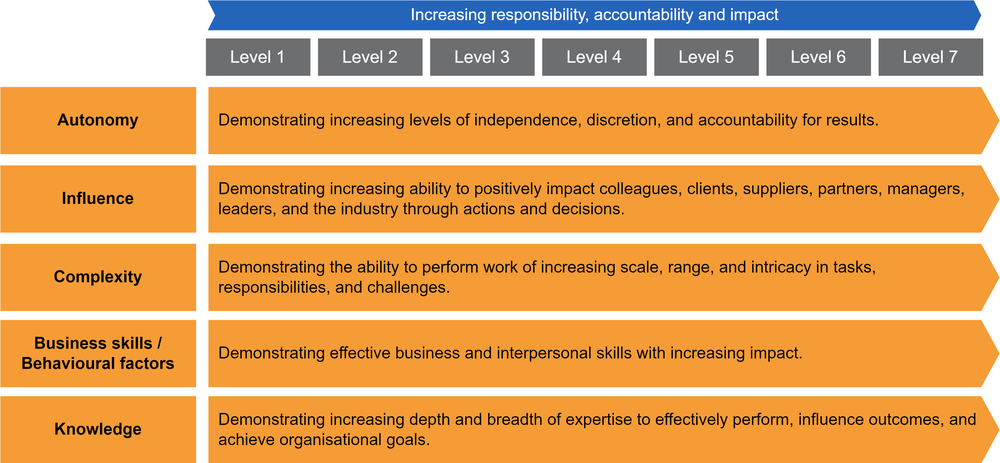
Autonomy, influence and complexity

The generic attributes of autonomy, influence and complexity in SFIA work together to provide a comprehensive picture of an individual's level of responsibility.
These generic attributes offer a universal language to describe professional growth across diverse roles and industries, independent of specific skills.
As professionals advance through SFIA levels, they typically experience a coordinated increase in all three generic attributes. This progression reflects an expansion of decision-making authority, broader impact on the organisation and its stakeholders, and the ability to handle more challenging and multifaceted work.
By using these generic attributes, SFIA enables organisations to make meaningful comparisons between different roles and to chart clear pathways for career development.
This approach ensures that SFIA remains relevant and applicable across various sectors and can adapt to evolving job roles in the rapidly changing digital landscape.
Business skills/behavioural factors

At each level of responsibility, professionals are expected to demonstrate a combination of business skills and behavioural factors that enhance their impact and effectiveness.
As individuals progress through SFIA levels, the expectations for these skills intensify and broaden in scope. For instance, at lower levels, collaboration might involve effectively working within a team, while at higher levels, it could mean orchestrating cooperation across multiple departments or even organisations.
By defining these at each level, SFIA provides a clear roadmap for professional development, ensuring that as professional responsibilities grow, so too does the ability to operate effectively in a business context, drive innovation and lead change.
This holistic approach recognises that success in technology-related roles requires not just technical proficiency, but also the ability to navigate complex business environments and inspire others towards shared goals.
For each business skill/behavioural factor, SFIA provides:
- Name: The name of the business skill/behavioural factor.
- Code: A unique 4 letter code for the business skill/behavioural factor.
- Short description: A short definition of the business skill/behavioural factor overall – to understand the scope and nature of the business skill/behavioural factor at a glance.
- Guidance notes: Additional information to clarify the scope and context.
- Level descriptions: Specific descriptions of how the business skill/behavioural factor is applied at each relevant level of responsibility.
Business skill/behavioural factor short descriptions
| Collaboration | Working effectively with others, sharing resources and coordinating efforts to achieve shared objectives. |
| Communication | Exchanging information, ideas and insights clearly to enable mutual understanding and cooperation. |
| Creativity | Generating and applying innovative ideas to enhance processes, solve problems and drive organisational success. |
| Decision-making | Applying critical thinking to evaluate options, assess risks and select the most appropriate course of action. |
| Digital mindset | Embracing and effectively using digital tools and technologies to enhance performance and productivity. |
| Leadership | Guiding and influencing individuals or teams to align actions with strategic goals and drive positive outcomes. |
| Learning and development | Continuously acquiring new knowledge and skills to enhance personal and organisational performance. |
| Planning | Taking a systematic approach to organising tasks, resources and timelines to meet defined goals. |
| Problem-solving | Analysing challenges, applying logical methods and developing effective solutions to overcome obstacles. |
| Adaptability | Adjusting to change and persisting through challenges at personal, team and organisational levels. |
| Improvement mindset | Continuously identifying opportunities to refine work practices, processes, products, or services for greater efficiency and impact. |
| Security, privacy and ethics | Ensuring the protection of sensitive information, upholding privacy of data and individuals, and demonstrating ethical conduct within and outside the organisation. |
Note: The behavioural factors have always been present in SFIA. In SFIA 9 they have been made more visible. In previous versions they have been part of the generic attributes and business skills descriptions.
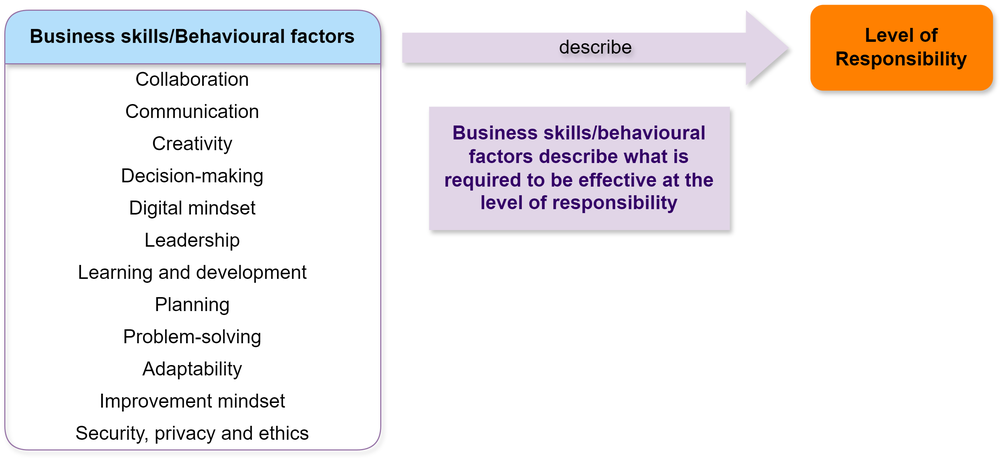
Integrating behavioural frameworks with SFIA
Many organisations use their own set of behaviours aligned with their corporate values, which will vary from one organisation to another.
- These behaviours can be mapped to SFIA’s generic attributes and behavioural factors, or SFIA can be used to complement them effectively.
- If an organisation lacks its own behavioural framework, SFIA’s behavioural factors provide a valuable foundation.
The SFIA behavioural factors can either be adopted as defined or used as a basis for developing the organisation's own behavioural model. This flexibility allows SFIA to integrate smoothly with diverse organisational cultures and structures, from SME to enterprise, enhancing its utility across different sectors and industries.
The Knowledge generic attribute

SFIA's Knowledge attribute is a fundamental component of the framework, outlining the breadth and depth of understanding required at each level of responsibility.
Knowledge in SFIA represents a progression from applying basic role-specific information to leveraging broad, strategic understanding that shapes organisational direction and industry trends. It involves:
- applying role-specific knowledge to perform routine tasks
- integrating general, role-specific and industry knowledge
- using understanding of technologies, methods and processes to achieve results
- applying in-depth expertise to solve complex problems
- leveraging broad knowledge to influence strategic decisions
- shaping organisational knowledge management practices.
Effective knowledge application develops through practical experience, formal education, professional training, continuous learning and mentorship. It encompasses the ability to apply understanding in real-world scenarios, adapt to emerging challenges and create value for the organisation.
As professionals progress through, their application of knowledge evolves from basic, role-specific tasks to strategic organisational leadership. This progression includes supporting team activities, applying practices within business contexts, integrating knowledge for complex tasks, offering authoritative advice and enabling cross-domain decision-making. At higher levels, professionals apply broad business and strategic knowledge to shape organisational strategy and anticipate industry trends.
Example
The breakdown of each level of responsibility can be found in the levels of responsibility section. SFIA Level 1 is shown here as an example.

Professional skills
SFIA professional skills represent a comprehensive range of specific competencies covering the breadth and depth of capabilities in today's digital, technological and business environments. Key features include:
- Flexible level structure: Each skill is defined at relevant levels of responsibility, reflecting real-world practices. Not all skills are defined at all seven levels, aligning with actual workplace needs.
- Focus on professional aspects: SFIA emphasises the professional application of skills rather than specific technologies, ensuring broader applicability.
- Adaptability across industries: The framework's structure allows for flexibility, making it relevant across various sectors and adaptable to evolving technological and business landscapes.
This approach provides a robust, industry-aligned framework for skills management, supporting activities such as organisational design, workforce planning, recruitment, learning and development, career progression and performance management in the roles that shape the digital world and its integration with business and society.
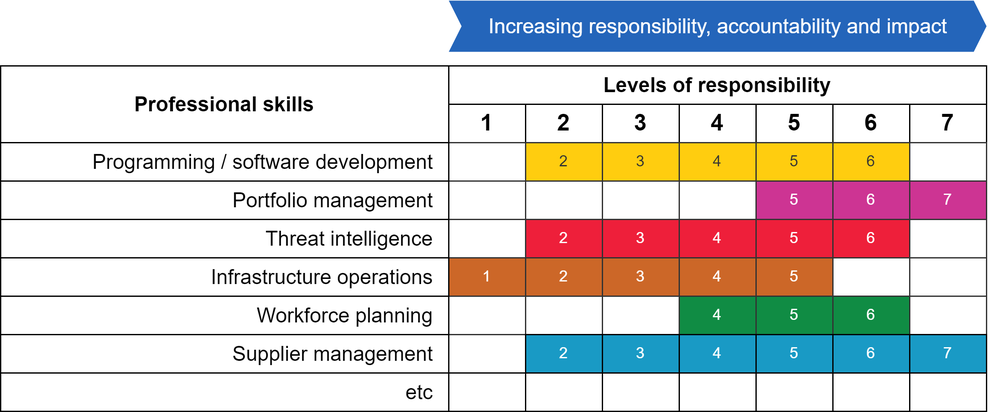
For each skill, SFIA provides:
- Skill name: The name of the skill
- Skill code: A unique 4 letter code for the skill
- Skill short description: A short definition of the skill overall – to understand the scope and nature of the skill at a glance
- Guidance notes: Additional information to clarify the scope and context.
- Level descriptions: Specific descriptions of how the skill is applied at each relevant level of responsibility.
The skills are consistently aligned with the seven levels of responsibility, ensuring that the expectations for each skill match the generic attributes of the corresponding level.
Integration of professional skills and generic attributes
In SFIA, skills and generic attributes can be used for two key purposes: defining the skill and level requirements of roles/jobs and assessing the people who perform those roles. These two aspects are complementary, ensuring clarity in role expectations and consistency in assessing individual contribution and performance.
SFIA integrates professional skills and generic attributes to offer a comprehensive framework for defining role expectations and assessing individuals. This integration ensures that professionals not only possess the necessary expertise but also the behaviours and qualities needed to perform effectively at each level of responsibility.
Professional skills and generic attributes work together to define overall competence:
- The generic attributes of autonomy, influence and complexity indicate the level of responsibility
- The knowledge generic attribute describe what you need to know to meet your level of responsibility.
- The business skills/behavioural factors describe the behaviours required to be effective at the level of responsibility
This combination of skills and attributes enables organisations to assess individuals holistically, ensuring that both professional and behavioural competencies align with organisational needs.
Defining role expectations and assessing and developing people
Professional skills, generic attributes including business skills/behavioural factors can be considered independently. This allows for a flexible approach to defining role and skill expectations while also providing a framework for assessing and developing the people who perform those roles.
Combined competence
For effective performance at a specific level, individuals must demonstrate both the professional skills and the corresponding generic attributes required for that level.
Example
If an individual is expected to perform a skill at Level 4, they must also exhibit the corresponding level of autonomy, influence and complexity defined for Level 4.
- Lower levels of autonomy, influence or complexity may hinder effective performance at the higher level, even with sufficient role-specific professional skills and knowledge.
- Note: The business skills/behavioural factors cover a range of attributes and may not all need to be demonstrated at the same level.
This integration ensures professionals are not only professionally capable but also exhibit the necessary behaviours and qualities to perform their roles effectively.
Professional skills and generic attributes work together to define overall competence
This diagram illustrates how SFIA levels of responsibility—defined by autonomy, complexity and influence—combine with professional skills to describe professional competency.
It highlights the interplay between generic attributes, impact in the workplace, business skills, behavioural factors and knowledge in shaping an individual's role and effectiveness.
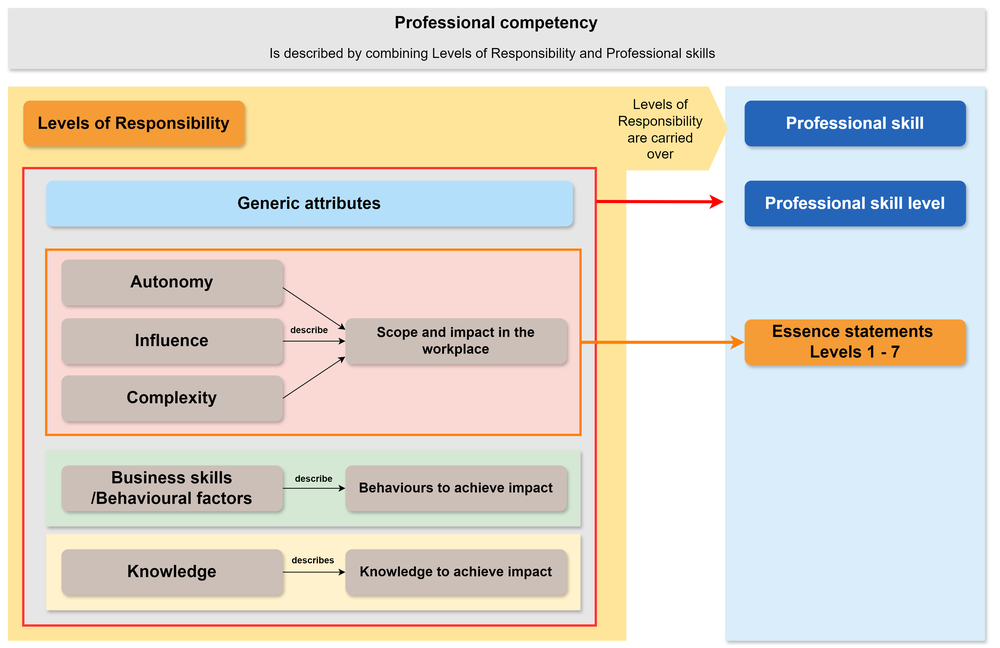
Illustrated example
SFIA's approach combines professional skills and generic attributes across the seven levels to provide a comprehensive framework for competence. This allows organisations and individuals to:
- Assess skills and behaviours: Evaluate both skills and behavioural attributes accurately.
- Identify development needs: Recognise gaps between current capabilities and the requirements of higher responsibility levels. Development may be focussed on professional skills and/or business skills/behaviours.
- Communicate expectations: Use a common language to define roles, responsibilities and career progression pathways. Communicate both professional and business skills/behavioural expectations using the same framework
This diagram illustrates this integration for one SFIA skill (Digital forensics) at Level 4.
